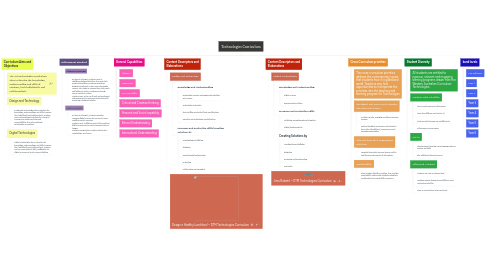
1. Curriculum Aims and Objectives
1.1. The WA technologies curriculum aims to develop the knowledge, understanding and skills of students, both individually and collaboratively.
1.2. Design and Technology
1.2.1. Design and Technologies aims to develop the knowledge, understandings and skills to ensure that, individually and collaboratively, students can produce designed solutions for a range of contexts and understand roles and responsibilities of people working in technologies occupations.
1.3. Digital Technologies
1.3.1. Digital Technologies aims to develop the knowledge, understandings and skills to ensure that, individually and collaboratively, students can use computational skills, confidently use digital systems and apply systems thinking.
2. General Capabilities
2.1. Literacy
2.2. Numeracy
2.3. ICT capability
2.4. Critical and Creative thinking
2.5. Personal and Social capability
2.6. Ethical Understanding
2.7. Intercultural Understanding
3. Student Diversity
3.1. All students are entitled to rigorous, relevant and engaging learning programs drawn from the Western Australian Curriculum: Technologies.
3.2. Students with Disability
3.2.1. have to make necessary adjustments.
3.2.2. draw from different year levels P-10
3.2.3. make practical changes e.g. modified tools
3.2.4. adjustments to assessments
3.3. EAL/D
3.3.1. simultaneously learning a new language and new content and skills
3.3.2. give additional time and support
3.4. Gifted and Talented
3.4.1. students can work at a deeper level
3.4.2. combine aspects of general capabilities or cross curriculum priorities
3.4.3. draw on content from other year levels
4. Content Descriptors and Elaborations
4.1. Design and Technology
4.1.1. Knowledge and Understanding
4.1.1.1. technologies contexts and engineering pinciples and systems
4.1.1.2. technologies and society
4.1.1.3. food and fibre production/ food specialisations
4.1.1.4. materials and technologies specialisations
4.1.2. Processes and Production Skills/Creating Solutions by
4.1.2.1. Investigating and defining
4.1.2.2. designing
4.1.2.3. producing and implementing
4.1.2.4. evaluating
4.1.2.5. collaborating and managing
4.2. Design a Healthy Lunchbox! – DTM Technologies Curriculum
5. Cross Curriculum priorities
5.1. The cross-curriculum priorities address the contemporary issues that students face in a globalised world. Teachers may find opportunities to incorporate the priorities into the teaching and learning program for Technologies
5.2. Aboriginal and Torres Strait Islander histories and cultures
5.2.1. provides creative, engaging and diverse learning contexts
5.2.2. explore Aboriginal and Torres Strait Islander's innovation of traditional, contemporary and emerging technologies
5.3. Asia and Australia's engagement with Asia
5.3.1. recognise interaction between human activity and diverse environments of Asia regions.
5.4. Sustainability
5.4.1. when students identify a problem, they consider sustainability and provide solutions taking into consideration the sustainability necessary.
6. band levels
6.1. Pre-Primary
6.2. Year 1
6.3. Year 2
6.4. Year 3
6.5. Year 4
6.6. Year 5
6.7. Year 6
7. Content Descriptors and Elaborations
7.1. Digital Technologies
7.1.1. Knowledge and Understanding
7.1.1.1. Digital systems
7.1.1.2. Representations of data
7.1.2. Processes and Production Skills
7.1.2.1. Collecting, managing and analysing data
7.1.2.2. Digital implementation
7.1.3. Creating Solutions by
7.1.3.1. Investigating and defining
7.1.3.2. designing
7.1.3.3. producing and implementing
7.1.3.4. Evaluation
7.2. Jimu Robots! – DTM Technologies Curriculum
8. Achievement Standard
8.1. Design and Technologies
8.1.1. By the end of Stage A, students react to significant designed solutions that meet their needs.With guidance, students experience designed solutions in at least one technologies context. They begin to communicate their needs and indicate a choice or preference through accept and reject actions. Students react to the use of tools and equipment and experience the sequenced steps involved in producing a designed solution.
8.2. Digital Technologies
8.2.1. By the end of Stage A, students recognise common digital systems that are used to meet specific everyday purposes. Students react to different types of data and how digital systems can be used to represent data as images. Students recognise that routine tasks involve completing a set of steps.
